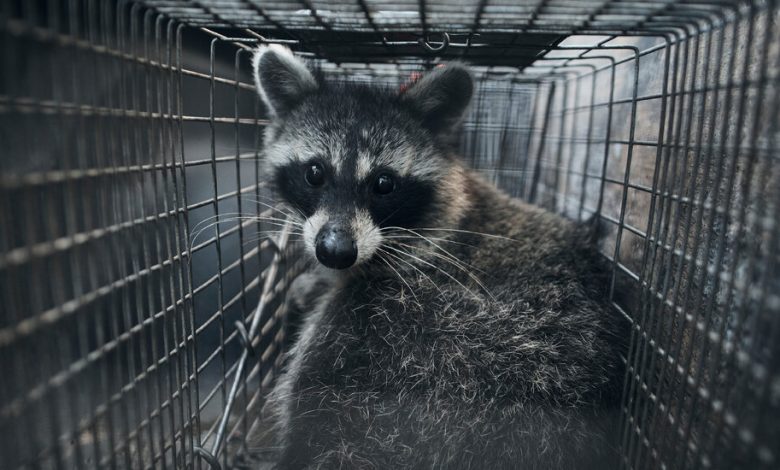In the Big City, Wildlife Researchers Are on the Prowl

Early one morning last month, Laura Dudley Plimpton found herself in Forest Park, in Queens, staring at a pair of captured raccoons. It was not the first time that Ms. Plimpton, an ecologist at Columbia University, had caught two of them in a cage trap designed for one. But typically when that happened, she would find a mother and a small kit inside.
This trap contained two fully grown, rotund adults, two balls of bristly fur that had merged into what one member of the trapping team called a single “big squish.” The raccoons seemed to be unbothered, one resting casually atop the other inside the cage, which had jumbo marshmallows as bait.
“You guys are so silly,” Ms. Plimpton said. Her demeanor was improbably cheery, and her French braid was impressively neat for someone who had arrived at the parkbefore dawn. “I really don’t know how they did that,” she added, turning toward a colleague. “They had to have raced each other to the marshmallow.”
For their trouble, the raccoons had earned themselves a quick veterinary exam, a rabies vaccine and a spot in Ms. Plimpton’s investigation: a study of urban animals, the pathogens they carry and how they might spread across the city.
Although rats receive most of the attention, New York City is crawling with all kinds of creatures — raccoons, skunks, opossums, deer and even the occasional coyote — that are not always visible to people. For these animals, urban living provides some clear opportunities, especially “if they learn to utilize human resources such as trash,” said Maria Diuk-Wasser, who leads Columbia’s eco-epidemiology lab, where Ms. Plimpton is a Ph.D. student.
But city life also poses distinct challenges for animals, which often live in close quarters and have frequent interactions with other species, including us. That can raise the risks of disease transmission to people, pets and wildlife.
So Ms. Plimpton, Dr. Diuk-Wasser and their colleagues are trying to learn more about these risks, in hopes of safeguarding both human and animal health. They are also shining a light on the way that our lives are intertwined with those of our animal neighbors, even in one of the most urban environments on Earth.
“We have all of these such close interactions with each other, whether we know it or not,” Ms. Plimpton said. “It’s always happening around us.”

Laura Dudley Plimpton, an ecologist at Columbia University, prepares a workstation for processing raccoons in Forest Park before dawn.
Raccoon roundup
For years, Dr. Diuk-Wasser has been investigating how urban environments shape animal communities and how that, in turn, might affect the spread of certain pathogens. She has been especially interested in tick-borne diseases and exploring how landscape features on Staten Island affect the movements of deer, which drop ticks as they bound through the borough. “We have identified a strong correlation between deer visitation and finding ticks in someone’s yard,” Dr. Diuk-Wasser said.
The Covid pandemic provided an opportunity to expand the research, especially when it became clear that people were regularly passing SARS-CoV-2, the virus that causes Covid, to deer, cats and other animals. The universe of coronaviruses is vast, and Ms. Plimpton and Dr. Diuk-Wasser wondered whether there were other coronaviruses circulating in the city’s wildlife that might pose a risk to animals or people.
“As we started looking for coronaviruses, we started finding all of these other pathogens,” Ms. Plimpton said. “And seeing the burden that some of these populations have in terms of their health.”
Last summer, Ms. Plimpton was trapping and swabbing raccoons in Brooklyn’s sprawling Green-Wood Cemetery when she began noticing animals with strange symptoms: hair loss, scabbed paws, vision problems and disorientation. It was an outbreak of canine distemper, a disease that researchers had not been looking for at first. “It just happened in front of our eyes,” Dr. Diuk-Wasser said.
Canine distemper is not a health threat to humans, but it is often fatal in raccoons and skunks and can also affect dogs. And because it can be mistaken for rabies, outbreaks can be a drain on city resources, requiring officials to collect and test symptomatic raccoons.
The researchers soon confirmed the virus in 11 raccoons, two cats and one skunk. They hope that by sequencing the genomes of the viral samples they collected, they can untangle the chain of transmission and map how distemper spread through the cemetery.
That work is ongoing, but the raccoons’ movements, which Ms. Plimpton tracked with GPS collars and Bluetooth sensors, provided clues.The area around the southwestern corner of the cemetery was a hot spot for raccoon interactions. That region contained the cemetery’s service yard, where many employees work and eat, as well as some residential yards where locals were known to leave food out for stray cats.
Although the idea remains unproven, Ms. Plimpton hypothesizes that the area might have served as a “super-spreading zone,” with trash, gardens and cat food that attracted hungry raccoons and brought the animals into close contact.
The cemetery has already taken action, switching to trash cans that are harder for animals to climb into and encouraging those who live nearby not to leave cat food out at night, said Sara Evans, the senior manager and curator of living collections at Green-Wood.“Establishing healthier or more effective boundaries with the wildlife that inhabit the city, it really just takes the cooperation of literally everyone,” Ms. Evans said.
‘All the swabbing’
The researchers are also investigating these relationships at a larger, citywide scale, with a collection of biological specimens from about 700 animals, including raccoons, deer, opossums, skunks, cats, shrews and white-footed mice. “I’m starting to get carpal tunnel from all the swabbing,” Ms. Plimpton said.
On Sept. 14, she was back in action at Forest Park. Her colleagues at the U.S. Department of Agriculture, who were leading the trapping effort, had traversed the park the previous evening, placing trapsin locations that seemed like promising raccoon territory. Large, old-growth oak trees often bring success. “It’s also pretty good to set near large areas of trash,” said Raven Schuman, a wildlife specialist at the U.S.D.A.
It was a good night of trapping, yielding 17 raccoons and four opossums. The next morning, the researchers began working through the animals one by one at their pop-up sampling site.
Ms. Schuman sedated the first raccoon. As soon as it conked out, the researchers got to work. “Once the animals go down, we have about 10 minutes,” said Ms. Plimpton, who swabbed the raccoon’s nose, mouth and rectum. Dr. Diuk-Wasser ran her fingers through the animal’s wiry hair, looking for ticks. Dr. Julian Rivera, a veterinarian at the Staten Island Zoo who was helping the researchers for the day, conducted a brief physical exam, drew blood and collected a few tiny tissue samples.
Then the next animal was up, and the three repeated their designated tasks. And so it went, for six nonstop hours. The animals varied widely in size, age and condition. “You are just a perfect specimen of a raccoon,” Ms. Plimpton cooed at one fluffy-eared kit, rubbing a gloved finger over its velvety paw. “This one is remarkably cute,” Dr. Rivera pronounced with veterinary expertise.
But an enormous adult, who had initially seemed robust, was not in great shape. He had ticks around his eyes and bald spots on his legs. Some of his teeth were missing and one paw appeared to be swollen. It was hard to know what ailed him, but his samples might provide a clue. His specimens, and all the others, would be sent to the researchers’ collaborators at Cornell and tested for coronaviruses, distemper and tick-borne pathogens.
So far, the scientists have not found any coronaviruses in raccoons, but they did isolate a novel coronavirus from a cat last summer. It was a type of coronavirus that had previously been associated with rabbits and rodents. Although it is not clear how the cat was infected, stray cats do sometimes feed on mice, and humans might unwittingly facilitate disease-spreading encounters; feeding stations for feral cats can also attract rodents, the researchers noted in a recent paper, which has not yet been published in a peer-reviewed journal.
Now that the specimens have been collected, they can be used for a wide range of future projects. Ms. Plimpton dreams of using an approach known as metagenomics to identify all of the viruses the animals in the city are carrying. “The hardest part is always getting samples from wildlife populations,” she said. “It’s a privilege whenever you get to sample these animals.”
When Ms. Plimpton finally finished her swabbing in Forest Park, the animals were released where they had been found. The pair of raccoons that had stumbled into the same trap slept off their sedation in their own individual cages. When they came to, Ms. Schuman carried them into the woods, setting the traps down on a dirt path.
The first raccoon, a slightly smaller female, immediately dashed out and tore down the trail. The larger male slowly waddled out. He took a few careful steps toward a small stand of trees as if he were testing the ground beneath his feet. Then, he picked up speed, gamboling into the thicket and, seconds later, out of sight.



